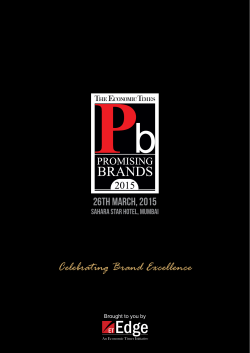
April 13, 2007 How to Turn Trash Into Treasure
April 13, 2007 they'd known since childhood, they had doubts about Coleman's quality. How to Turn Trash Into Treasure Smaller Firms Hone Ways To Revive 'Orphan' Brands Cast Off by Large Companies By ELLEN BYRON April 13, 2007; Page B1 When Martin Franklin, chief executive of Jarden Corp., acquired Coleman camping goods two years ago, he knew he was taking on a tired business. Coleman, though still selling its familiar coolers and lanterns at discounters such as Wal-Mart Stores Inc. and Target Corp., had few new products in development after its previous owner had filed for bankruptcy protection. What's more, it was caught in a waning interest in outdoor recreation as young people increasingly turned to digital adventures rather than the wild. Coleman was also trapped in a classic squeeze play. As a mass-market brand, it had to fend off competition from low-price, store-brand products. On the high end, nimble competitors were selling high-tech alternatives. And despite many outdoor enthusiasts harboring nostalgia for a brand Prestige Brands Holdings has acquired and tweaked well-known brands like these. Mr. Franklin saw opportunity nonetheless. "We look for brands that are market leaders but haven't been innovative," he says of his acquisition choices, which include other niche products with famous names such as Ball canning jars, Bicycle playing cards and Crock-Pot cookers. "We had to make Coleman the innovator again." Mr. Franklin is in the vanguard of executives who are refining ways to turn one company's trash into another's treasure. Under pressure to deliver growth, a number of consumer-products titans, including Procter & Gamble Co., Unilever and Colgate-Palmolive Inc., have been selling well-known but underperforming brands to better focus on those with more potential. Smaller firms trying to play Dr. Frankenstein have bought such familiar castoff brands as Sure and Right Guard deodorants, Comet cleaner, Aqua Net styling products, Pert Plus shampoo and Rit dye. As the pace of deals has quickened, it has become clearer just what works and what doesn't in nursing a so-called orphan brand back to health: acquire prominent brands, dominate niches, reinvigorate marketing and develop new products bearing the old trusted name. Picking the right brand in a clearly defined niche is critical. "Sometimes brands have been orphaned because they're in too small a category for their big owners," says Bill Chappell, a SunTrust Robinson Humphrey analyst, citing Prestige Brands Holdings Inc.'s dominance in wart removers, where it owns two brands, including Compound W. Small niches can be carved out of bigger categories, too, Mr. Chappell says, noting Prestige-owned Comet, which is a leading brand among abrasive household cleaners that sell for about $1. "It's simply a matter of focus," says Rick Milenthal, chairman of TenUnited, a Columbus, Ohio-based marketing agency that specializes in campaigns to revive old brands, including Chloraseptic sore-throat treatment, Prell shampoo and Comet in recent years, and is now working on boosting Pert Plus and Sure deodorant. "If you can fund marketing and fund distribution, you're going to have success," he says. With Chloraseptic, Mr. Milenthal says focusing on how consumers hate staying home when they're ill helped to inspire new products. Developing new medications that can be taken on the go, including dissolvable strips in compact boxes, helped to distinguish Chloraseptic from competitors, he says. Pitfalls abound, though. As major retailers narrow their inventories to just a few leading brands and their own private labels, smaller players often get nudged aside. "Companies run into the biggest problems when they acquire a No. 3 or 4 brand in a very large market," says Mr. Chappell. Even when operating in niche categories, success can be elusive. Prestige, which also owns Prell, Cutex nailpolish remover and Spic and Span cleaner, this week gave notice that its fourth-quarter results would be lower than the year before, blaming declining revenue in its personalcare business and a weaker-thananticipated cold and cough season. Innovative Brands is giving retailers more choices of Sure deodorant. At a conference this week, Chairman and Chief Executive Mark Pettie kept an optimistic tone, outlining a number of growth strategies under way. Those include plans to broaden retail distribution, better focus research and development on fewer and bigger ideas, as well as reduce the number of suppliers in order to gain purchasing efficiencies and scale. Providing better service to retailers can also win advantages for smaller brands, says Jahm Najafi, CEO of Najafi Cos., a private investment firm whose portfolio company, Innovative Brands LLC, last year bought Sure and Pert Plus from P&G. "There is opportunity to focus on them in more of a small, entrepreneurial company," he says of the brands. Early efforts to revive Sure and Pert Plus have focused on giving retailers more choices, including customized fragrances. He anticipates his company will be acquiring more brands in the near future. To resurrect the Coleman brand, Mr. Franklin decided he needed to develop more points of distribution and a fresh ad campaign. He hired a new division leader, Gary Kiedaisch, an avid outdoorsman who first focused on rallying employees, many of whom had become disillusioned with the neglect it got from its string of former owners. Mr. Kiedaisch was also waging a bigger campaign, trying to convince more consumers to enjoy nature. "When they see Coleman's in-store merchandising, it should inspire them to go outdoors," he says. To bring the brand back upscale and win over more serious campers, Coleman offered specialty retailers several new products unavailable in mass-market chains. "Coleman three years ago wouldn't have gotten into our stores," says Jim Potts, cofounder of Lewis & Clark Outdoors Inc., a chain of outdoors stores in Arkansas. "They weren't well-respected by outdoor enthusiasts, and there were questions about the quality of the product." But after hearing about Coleman's new products targeting more serious campers and hikers, Mr. Potts reconsidered. Last month, his stores launched a large display of Coleman products that can't be found at the Wal-Mart stores nearby, including highquality folding chairs and compact gas stoves. Now that he's in the peak-selling presummer season, he says sales of Coleman products have been strong. Coleman sales last year grew 10% to $901 million, and operating income rose nearly 10% to $84 million Chloraseptic, long known for its throat spray, has been spun into an array of products by Prestige Brands. This week, Jarden acquired another outdoorgoods company, Pure Fishing Inc., a maker of fishing tackle, lures, rods and reels with brands including Berkley, Abu Garcia and Trilene. These brands will keep their names, but will be placed under the Coleman umbrella and be promoted along with those products. German firm Henkel KGaA is banking on similar success. Last year it snapped up deodorant brands Right Guard, Soft & Dri and Dry Idea from P&G, which had to divest itself of some of its deodorant brands when it acquired Gillette. Plagued by mediocre sales in the slowgrowing deodorant category, Right Guard didn't measure up to the growth potential of P&G's other deodorants, which include Old Spice, one of the market leaders. Nevertheless, Henkel marketers smelled opportunity. "It wasn't a hard thing to learn that this brand had strong equity," says Ruediger Vetter, a vice president of marketing. "Right Guard has been known as an underarm protector par excellence for a long time." Instead of trying to immediately relaunch the Right Guard deodorant, last month the company introduced a brand extension -- its first body spray, dubbed RGX, with the tagline "Powered by Right Guard." Henkel executives hope the new product line will reinvigorate the overall Right Guard brand and carve out a new niche in the highly competitive, but lucrative, body spray category. Henkel executives say they are focusing on differentiating RGX from more-established competitors. As Unilever's Axe and P&G's Tag are locked in a battle over adolescent boys, Henkel's RGX targets slightly older men. "Some men are too mature for the Axe/Tag concept: Do they want to have an overpowering fragrance their girlfriend can smell from far away? No." says Mr. Vetter. Write to Ellen Byron at ellen.byron@wsj.com1
© Copyright 2025




















